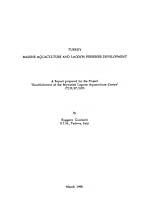
 | TURKEY
MARINE AQUACULTURE AND LAGOON FISHERIES DEVELOPMENT |
A Report prepared for the Project
“Establishment of the Beymelek Lagoon Aquaculture Centre”
(TUR/87/029)
by
Ruggero Guidastri
S.T.M., Padova, Italy
March 1995
On December 1994 the marine fish hatchery of the Beymelek Lagoon Aquaculture Centre (Sü Ürünleri Üretim ve Gelistirme Merkez Müdürlügü - Kale, Antalya) started its second seabream fry production. On January 1995 it was followed by seabass fry production.
The hatchery activity is running on a regular schedule. All units are working in a proper way and all the minor technical problems faced during the start up of the second production season have been solved.
For two years in succession, the local hatchery staff have been trained and thoroughly tested under true mass production conditions. It is believed that its technical skillness is at present well sufficient to run the hatchery without any further technical supervision. A greater commitment is however requested to guarantee continuity of results, as well as more attention has to be paid on the day-by-day routine work.
When the consultant left (end of February), no fingerling counting was available due to their early age. However, based on the production experience of last year until April 1994, a good estimate of the hatchery final output can be assessed.
In the larval unit a fairly higher larval density of seabream larvae on a greater number of tanks than last year was achieved and three out of five weaning tanks stocked with seabream eggs were running at least at the same level of 1994. Considering a total amount of 4958000 viable larvae with a conservative final survival rate of 8%, the overall final seabream output should be around 400000 fry.
As regards seabass production, four weaning tanks and five spawning tanks have been stocked with eggs for a total amount of 4794000 viable larvae. Adopting a conservative final survival rate of 20%, production should not be less than 1000000 fingerlings.
Hyperlinks to non-FAO Internet sites do not imply any official endorsement of or responsibility for the opinions, ideas, data or products presented at these locations, or guarantee the validity of the information provided. The sole purpose of links to non-FAO sites is to indicate further information available on related topics.
This electronic document has been scanned using optical character recognition (OCR) software. FAO declines all responsibility for any discrepancies that may exist between the present document and its original printed version.
1.1 Terms of reference
1.2 Programme of the mission
3.1 Rearing facilities
3.2 Stock inventory
3.3 Breeder handling and feeding
3.4 Hormonal treatment
3.5 Egg production
3.6 Staff
4.1 Algal sub-section
4.2 Rotifer sub-section
4.3 Artemia sub-section
4.4 Staff
5.1 Rearing facilities
5.2 Production strategy
5.3 Rearing system
5.4 Results
5.5 Pathology
5.6 Staff
6.1 Rearing facilities
6.2 Rearing system
6.3 Staff
8. POST-PRODUCTION MAINTENANCE
10. OTHER FACILITIES AT THE BEYMELEK CENTRE
A.1 Broodstock section: present stock consistency of female seabream and seabass (February 1995)
A.2 Broodstock section: egg production, December 1994
A.3 Broodstock section: egg production, January 1995
A.4 Broodstock section: egg production, February 1995
A.5 Broodstock section: hormoneal treatment, egg production and quality
A.6 Broodstock section: fertility rates and egg quality in seabream and seabass
A.7 Broodstock section: fertility rates in 1993–4 and 1994–5
A.8 Broodstock section: average egg size in seabream and seabass
A.9 Live food section: algal production results
A.10 Live food section: daily controls by the section head
A.11 Live food section: rotifer production results
A.12 Live food sectioartn: artemia production results
A.13 Live food section: artemia daily program
A.14 Live food section: consumption of expendable material in 1994–5 and foreseen needs for 1995–6
A.15 Larval section: seabream (stocking and hatching rate)
A.16 Larval section: seabass (stocking and hatching rate)
A.17 Larval section: compared hatching rates and percentage of viable larvae of the following seasons 1993–4 and 1994–5
A.18 Larval section: swimbladder activation, repletion rate and urinary calculus frequency in seabream larvae
A.19 Larval section: swimbladder activation, repletion rate and urinary calculus frequency in seabass larvae
A.20 Larval section: prophylactic treatment of larvae
A.23 Officials attending the meetings held in Ankara on February 20,21 and 22, 1995
A.25 Books of relevant interest on marine aquaculture
A.26 Periodicals of relevant interest on marine aquaculture
Acronyms used in the text
| CCAP | Culture Collection of Algae and Protozoa, Scotland |
| DHA | Docosahexaenoic acid (n-3 unsaturated fatty acid) |
| EPAC | Economic Products for Aquaculture (by INVE, Belgium) |
| GDAPD-MARA | General Directorate of Agriculture Production and Development, MARA, Ankara |
| hCG | human Chorionic Gonadotropin |
| HUFA | highly unsaturated fatty acids |
| IU | International Units |
| LH-RHa | Luteinizing Hormone-Releasing Hormone analogue |
| MARA | Ministry of Agriculture and Rural Affairs, Ankara |
| n.a. | not available |